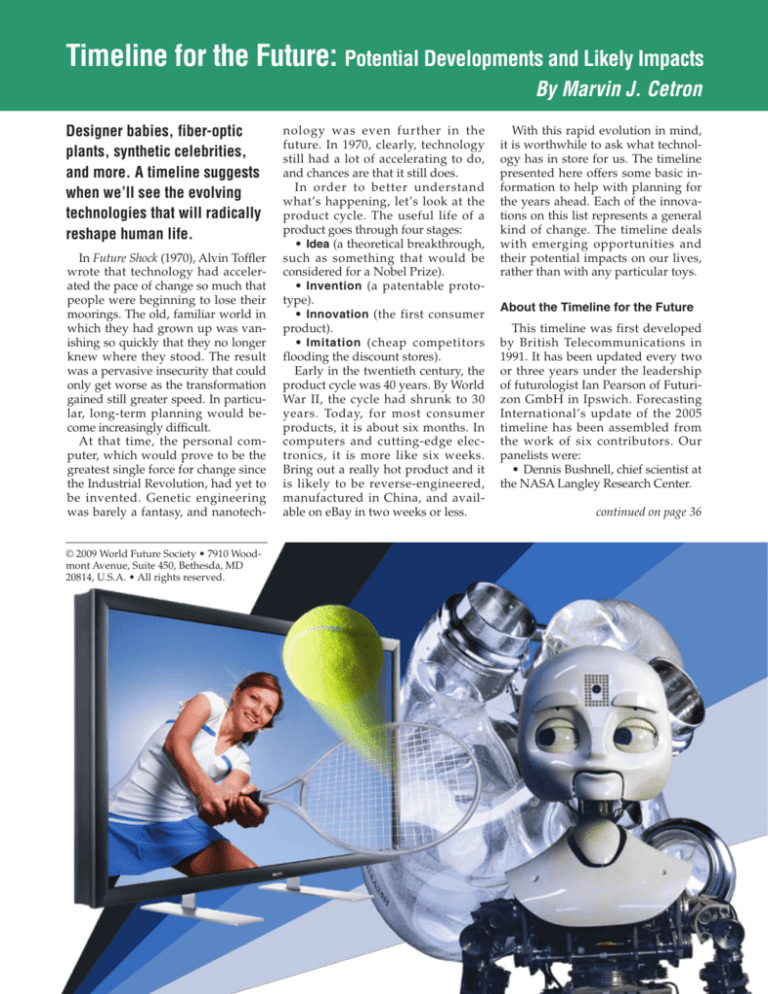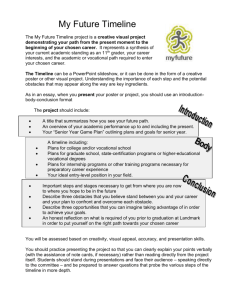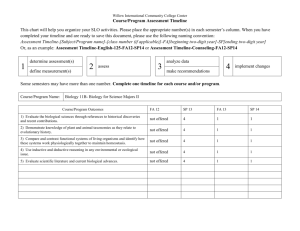
Timeline for the Future: Potential Developments and Likely Impacts
By Marvin J. Cetron
Designer babies, fiber-optic
plants, synthetic celebrities,
and more. A timeline suggests
when we’ll see the evolving
technologies that will radically
reshape human life.
In Future Shock (1970), Alvin Toffler
wrote that technology had accelerated the pace of change so much that
people were beginning to lose their
moorings. The old, familiar world in
which they had grown up was vanishing so quickly that they no longer
knew where they stood. The result
was a pervasive insecurity that could
only get worse as the transformation
gained still greater speed. In particular, long-term planning would become increasingly difficult.
At that time, the personal computer, which would prove to be the
greatest single force for change since
the Industrial Revolution, had yet to
be invented. Genetic engineering
was barely a fantasy, and nanotech© 2009 World Future Society • 7910 Woodmont Avenue, Suite 450, Bethesda, MD
20814, U.S.A. • All rights reserved.
nology was even further in the
future. In 1970, clearly, technology
still had a lot of accelerating to do,
and chances are that it still does.
In order to better understand
what’s happening, let’s look at the
product cycle. The useful life of a
product goes through four stages:
• Idea (a theoretical breakthrough,
such as something that would be
considered for a Nobel Prize).
• Invention (a patentable prototype).
• Innovation (the first consumer
product).
• Imitation (cheap competitors
flooding the discount stores).
Early in the twentieth century, the
product cycle was 40 years. By World
War II, the cycle had shrunk to 30
years. Today, for most consumer
products, it is about six months. In
computers and cutting-edge electronics, it is more like six weeks.
Bring out a really hot product and it
is likely to be reverse-engineered,
manufactured in China, and available on eBay in two weeks or less.
With this rapid evolution in mind,
it is worthwhile to ask what technology has in store for us. The timeline
presented here offers some basic information to help with planning for
the years ahead. Each of the innovations on this list represents a general
kind of change. The timeline deals
with emerging opportunities and
their potential impacts on our lives,
rather than with any particular toys.
About the Timeline for the Future
This timeline was first developed
by British Telecommunications in
1991. It has been updated every two
or three years under the leadership
of futurologist Ian Pearson of Futurizon GmbH in Ipswich. Forecasting
International’s update of the 2005
timeline has been assembled from
the work of six contributors. Our
panelists were:
• Dennis Bushnell, chief scientist at
the NASA Langley Research Center.
continued on page 36
2010-2014
2015-2019
2020-2024
Artificial
Intelligence and
Artificial Life
Behavior alarms based on human mistake recognition 2010
Software is trained, rather than written 2010
Artificial nervous systems for autonomous robots 2010
25% of TV celebrities are synthetic 2015
Machine knowledge exceeds human knowledge 2020
Electronic life-form given basic rights 2020
Artificial insects and small animals with artificial
brains 2020
Biotechnology,
Health, and Medicine
Retinal implants linked to external video cameras 2010
Designer babies 2012
Artificial heart (lab-cultured
or ­entirely synthetic) 2015
Some implants start to be seen
as ­status symbols 2017
Artificial lungs, kidneys 2017
Artificial liver 2020
Nanobots in toothpaste attack plaque 2020
Fully functioning artificial eyes 2020
Artificial peripheral nerves 2020
Business and
Education
Computing
Environment and
Resources
80% of U.S. homes have PCs 2010
Virtual reality used to teach science, art, history, etc. 2012
3-D video conferencing 2014
Optical neurocomputer 2012
DNA computer 2014
Supercomputer as fast as human brain 2014
Commercial magma power stations 2011
Clothes collect and store solar power 2012
Effective prediction of most natural disasters 2014
JEFF MILLER / UNIVERSITY OF WISCONSIN–MADISON
2014: DNA computer. University
of Wisconsin–Madison scientists
have taken DNA computing from
the test tube to a solid surface.
The gold chip shown here contains millions of DNA molecules
capable, with the help of enzymes that act like software, of
solving a relatively complex
problem.
SCOTTEVEST INC.
Quantum computer 2015
All technology imitates thinking
processes of human brain 2018
ABIOMED
2015: Artificial heart. The
AbioCor is a completely
self-contained replacement
heart designed to sustain
the body’s circulatory system. It is intended for endstage heart failure patients.
Battery-operated and
equipped with an internal
motor, the AbioCor is able
to move blood through the
lungs and to the rest of the
body, simulating the rhythm
of a heartbeat.
Wild Card:
Significant IT attack
brings down major
country economy.
Library of Congress contents available in sugar-cubesized device 2020
Desktop computer as fast as human brain 2021
DONNA COVENEY / MIT
Insectlike robots used for crop pollination 2015
Carbon-dioxide fixation technologies for environmental
protection 2015
Synthetic, nonpetroleum aviation fuel 2018
Home and Leisure
Fiber-optic plants used in gardens 2010
Smart paint containing computer chips is available 2013
Living rooms decorated with virtual-reality scenes 2015
Holographic TV 2018
Experience-recording technology developed 2023
Machine / Human
Interface
Voice-activated interface for home appliances 2010
Computer screens in clothes 2010
Tactile sensors, comparable to human sensation 2012
Computers linked to biological sensory organs 2012
Global sensor grid 2018
First Bionic Olympics 2020
LINDEN LAB
Robotics
2011: First Internet war
fought between cybercommunities. A scene
from Second Life, a virtual
online world inhabited by
millions of residents from
around the globe.
2012: Clothes collect and store solar
power. This jacket from Scottevest
utilizes thin-film solar technology that
allows you to charge your cell phone and
iPod while you walk.
Self-diagnostic, self-repairing robots 2015
Houses built by robots 2015
Self-monitoring infrastructures 2015
Robots for almost any job in homes and hospitals 2015
Realistic nanotech toy soldiers are built 2022
2018: All technology imitates
thinking processes of human
brain. MIT’s Nexi MDS Robot
has been designed to effectively convey a wide range of
human emotions.
PHILIPS
2018: Holographic TV. Threedimensional television may
soon hit the consumer market,
and interactive 3-D applications
such as online games are being
developed as well. Recent
developments in 3-D screens
mean that special viewing
glasses are no longer required.
Security, Law,
and War
First Net war fought between cybercommunities 2011
People’s courts on Internet for minor disputes 2012
Virtual reality routinely used in courtrooms for evidence presentation 2013
ID cards replaced by biometric scanning 2014
Electromagnetic communications disrupted 2015
Space
Near-Earth space tours (suborbital) 2012
Wild Card:
Space tugs take satellites into high orbits 2015
Zero point energy engineered/commercialized;
all other energy sources
become obsolete.
Reservations required for some key roads 2018
Airplanes 75% more fuel-efficient 2020
Driverless truck convoys using electronic towbar 2022
Spectacles that translate signs, labels 2015
Computer-enhanced dreaming 2020
Travel and
Transportation
Wearable and
Personal Technology
Portable translation device for s­ imple conversation
available on consumer market 2010
2025-2029
2030-2039
Artificial
Intelligence and
Artificial Life
Genetically engineered electronic toy/pet developed 2025
Robots are physically and mentally superior to humans 2032
Biotechnology,
Health, and Medicine
Only 15% of deaths worldwide due to infectious diseases 2025
Life extension at one year per year 2025
Artificial brain implants 2030
Business and
Education
Molecular manufacturing 2025
Individualized education programs for all students 2025
Wild Card:
Environment and
Resources
Discovery of artifacts
that force reconsidering
significant aspects of
common understanding
of human history.
Machine / Human
Interface
Full direct brain link 2025
Robotics
Robot population surpasses human population in the developed world 2025
Security, Law,
and War
Emotion-control chips used to control criminals 2025
Space
Space hotel accommodates 350 guests 2025
Teleportation at the particle level 2025
FAA approves autonomous drone airliners 2026
Hydrogen-fueled executive jets ­(cryoplanes) 2028
continued from page 33
•Ian Pearson, the forecaster most
familiar with this timeline.
•William Halal of George Washington University, whose company,
TechCast LLC, periodically devises a
similar timeline (see page 39).
•Murray Smith, Professional Pilot’s
publisher and resident expert on the
future of aviation.
•A senior R&D expert at the Department of Defense who chose to
remain anonymous.
•The staff of Forecasting International.
The six wild cards were provided
by John L. Petersen, president and
36
THE FUTURIST
March-April 2009
founder of The Arlington Institute, a
research institute that specializes in
thinking about global futures. The
wild cards do not necessarily represent the opinions of the author or the
World Future Society.
What the Timeline Reveals
Since the previous iteration of this
timeline was published in THE
FUTURIST (March-April 2006), the
panel has adjusted its expectations
for some events. For instance, the anticipations of fully functional artificial eyes and peripheral nerves have
been pushed ahead from the 2030s
and beyond to the 2020s.
ESA / DLR / FU BERLIN (G. NEUKUM)
Renewable energy replaces fossil carbon 2030
2040: First manned mission to Mars. A perspective view of
Hebes Chasma on Mars. A chasma is a deep valley with
steep sides.
Robots replace humans in workforce completely 2035
Asteroid diversion technology used as weapon 2040
Space factories for commercial production 2035
Wild Card:
Travel and
Transportation
2040 and Beyond
Bio / nano experiment
gets out of control;
regional or global
impact.
In choosing target dates for the
timeline, we assume that the item
will be readily available, but not yet
a commodity item. Consumer products will be found at specialty stores
and perhaps high-end department
stores, but not yet at Wal-Mart.
Our panel members agreed fairly
well about when most of the new
technologies could be expected. In
many cases, all six participants chose
the same date. Where due dates were
spread, we generally took the median date. If we at Forecasting International felt especially strongly
about the issue, we may have had
our thumbs on the scale when making the final decision, but it did not
Moon base the size of a small village is built 2040
First manned mission to Mars 2040
Start of construction of manned Mars laboratory 2048
Use of human hibernation in space travel 2052
Teleportation of a human being 2040
happen frequently.
Often, the date when a technology
reaches practical use depends less on
any technical obstacles than it does
on external factors. To be adopted,
an innovation must be technically
feasible, economically feasible, and
both socially and politically acceptable.
The space program is one obvious
example. The space-related events
on our timeline all assume that putting human beings into space will remain a priority, but that is not guaranteed. In the United States, for
instance, future administrations
might downgrade human spaceflight
in favor of automated probes. In that
case, the events on our timeline will
be replaced by safer, if less stirring,
activities, and the dates will need
significant adjustment.
In some cases, the fate of a technical innovation can be decided by a
very small group of managers. In
other cases, the decision must be
reached by a much broader consensus. Sometimes it is a matter of political will.
However, business and life both
require management that is becoming ever more difficult in a time of
accelerating change. We hope that
this timeline will help to make the
future just a bit less shocking and
bring it a bit more under control.
“What must be remembered by
anyone preparing for the future is
that technology change isn’t very important in itself,” says Pearson.
“What matters is what this change
enables or destroys.”
❑
About the Author
Marvin J. Cetron is president
of Forecasting International
Ltd. and a member of the
World Future Society board
of directors. E-mail glomar@
tili.com.
This article draws from an
earlier version published by Professional Pilot magazine (October 2008) and is used
with permission.
THE FUTURIST
March-April 2009
37









